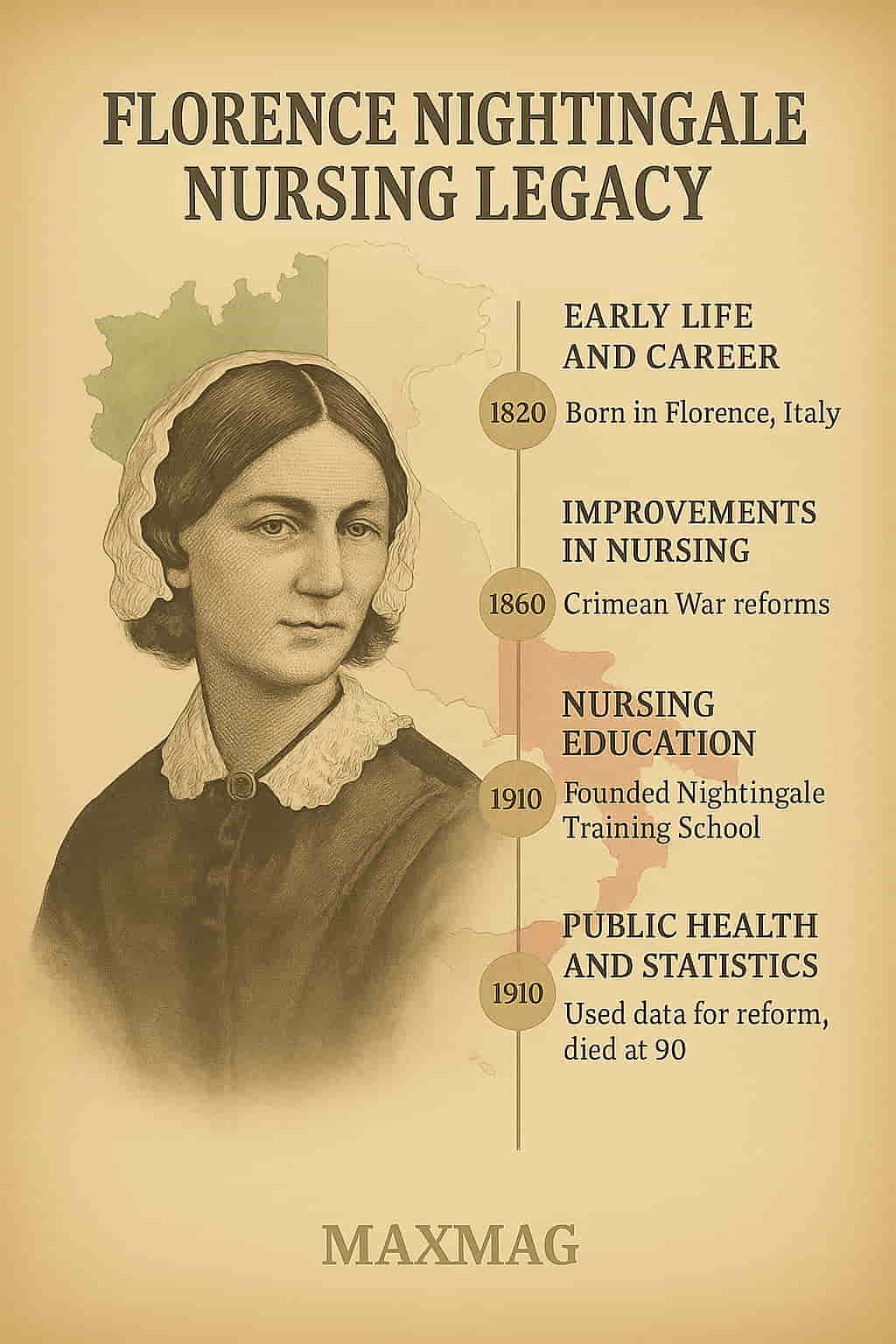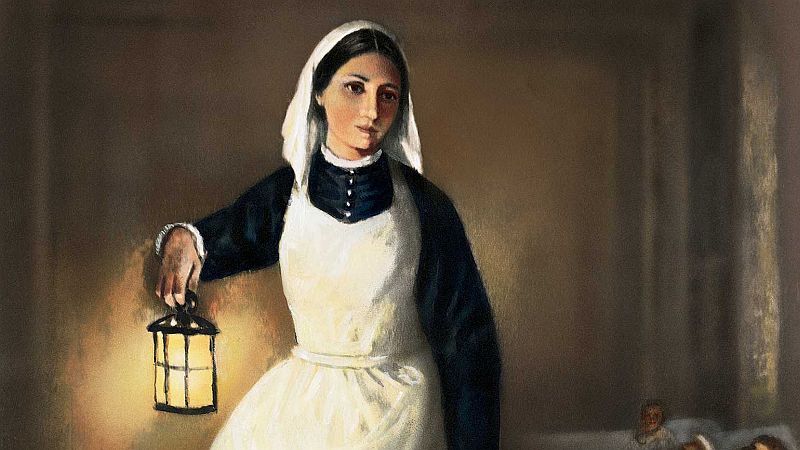
In modern healthcare, few names resonate as profoundly as Florence Nightingale. Her steadfast compassion on the battlefield and her groundbreaking approach to hygiene and data analysis continue to influence nursing education, policy, and patient care around the globe. Her story isn’t just a historical anecdote—it’s a living movement. The Florence Nightingale nursing legacy stretches from mid-19th-century hospitals to contemporary health crises, continuously shaping the way we define and deliver nursing care today.
Originally a well‑educated aristocrat fluent in multiple languages and trained in mathematics, Nightingale forsook societal expectations to become a nurse at a time when nursing was viewed as menial labor. Amid squalid military hospitals during the Crimean War, she implemented transformative sanitation measures—ventilation, handwashing, nutrition—that cut mortality rates dramatically. But she didn’t stop at cleaning wards; she meticulously recorded data, built compelling statistical visuals, and used them to influence systemic healthcare reform. That blend of humanism, scientific method, and policy advocacy became the enduring Florence Nightingale nursing legacy.
Early Life: The Spark That Ignited a Movement
Florence Nightingale was born in 1820 in Florence, Italy—hence her name—as the second of two daughters in a wealthy British family. Traveling Europe in childhood, she tasted Italian air, English countryside, and classical education. Her upbringing fostered an intense sense of intellectual curiosity, and by 14 she was reading theology, history, and science.
Despite her privileged background, Nightingale experienced a spiritual calling to nursing. In her own words, she felt “a divine vocation” to tend the sick and suffering. In 1851, she trained under Pastor Theodor Fliedner at Kaiserswerth’s deaconess program, then studied hospital systems in Paris and Rome, exposing her to models of organized, disciplined caregiving. These early experiences were the blueprint for what would become the Florence Nightingale nursing legacy.
The Crimean War: Rewriting the Rules of Care
When war broke out in 1854, Nightingale led a team of 38 nurses to military hospitals in Scutari (modern-day Üsküdar, Istanbul). The conditions were appalling—overflowing wards, contaminated water, rampant infection, and disorganization. Soldiers weren’t dying from battle wounds; they were succumbing to preventable diseases like cholera and typhoid.
She quelled the crisis by enforcing strict cleanliness: standardized handwashing, linen changes, improved ventilation, purified water, and a newly built sewage system. Mortality rates plummeted from 42% to under 2%—an astonishing public health turnaround.
But Nightingale didn’t rely on mere observation. She systematically gathered data on fatalities, disease, and environment, and turned them into striking Polar Area diagrams (sometimes referred to as “coxcomb charts”)—the first use of statistical infographic to influence public policy. Armed with these visuals, she convinced government leaders to overhaul military hospital infrastructure. That pivotal impact marks a cornerstone of the Florence Nightingale nursing legacy.
How the Florence Nightingale Nursing Legacy Revolutionized Education
Upon her return to London, Nightingale realized lasting change required institutionalizing her methods. Consequently, she founded the Nightingale Training School for Nurses at St. Thomas’ Hospital in 1860. It was more than a vocational setup—it was a pioneering academic environment blending hands-on skills with theory, ethics, and critical thinking.
Graduates from this program became ambassadors for the Florence Nightingale nursing legacy, establishing new nursing schools and healthcare systems globally: from Philadelphia’s Bellevue Hospital to the Government Nursing School in Madras (now Chennai). Her philosophy—nursing as a respected profession built on science, compassion, and accountability—became universal.
One contemporary bastion of this enduring tradition is the Florence Nightingale Faculty of Nursing, Midwifery & Palliative Care at King’s College London, which continues to spearhead global research and education initiatives aligned with Nightingale’s vision.
Public Health Engagement: Expanding the Legacy Beyond Hospitals
Healthcare, Nightingale believed, could not be confined to hospital walls—it needed to reach entire populations. She championed district nursing programs in the 1860s: trained professionals dispatched into impoverished urban neighborhoods to deliver home-based care. These district nurses not only treated the sick but eradicated pests, diagnosed epidemics, and educated families about sanitation and nutrition.
Moreover, Nightingale pressed for reforms in public sanitation: installing proper sewage, ensuring potable water, and redesigning buildings for better ventilation. She advised India’s Army Medical Department on barracks hygiene and formulated sanitation standards in workhouse infirmaries. By intertwining nursing, preventive care, and social equity, she cemented the Florence Nightingale nursing legacy as a catalyst for broader civic transformation.
Statistical Innovation: Visualizing Health for Impact
Nightingale’s innovation wasn’t limited to numbers—it was how she visualized them. Her iconic polar-area diagrams illustrated monthly mortality causes in absolute clarity. It wasn’t mere fashion; it was a radical communication tool.
Her statistical success won her the title of the first female member (non-voting) of the Royal Statistical Society in 1858 and later an honorary membership with the American Statistical Association. Today, infographics and data dashboards in epidemiology owe a direct intellectual debt to her.
By embedding data into care models, she reinforced one of the key tenets of the Florence Nightingale nursing legacy: measurable, evidence-based decisions save lives.
The Lady with the Lamp: Symbolism Anchored in Substance
The evocative image of Nightingale carrying a lamp through wounded soldiers during nightly rounds earned her the affectionate title—“The Lady with the Lamp.” This image traveled across paintings, newspapers, and eventually museums. It became a universal symbol of nursing—representing vigilance, compassion, and calm amidst suffering.
In London’s Florence Nightingale Museum, her lamp is displayed, not as an artifact of mere romanticism, but as a beacon for caregivers everywhere. The legend of the lamp, embedded in the Florence Nightingale nursing legacy, continues to spark public imagination and professional dedication alike.
Global Adoption: Nightingale’s Principles in Practice Everywhere
Nightingale’s concepts were not just preserved—they proliferated. In the U.S., Florence Nightingale’s model directly influenced early nursing programs like Bellevue (NYC), Boston City Hospital, and Johns Hopkins. In colonial India and Australia, her hygiene standards informed medical policy. The global rise of district nursing empowered communities with local healthcare designed after her blueprint.
International organizations also echo her legacy. The International Committee of the Red Cross emphasizes nursing safety in conflict zones, while Doctors Without Borders (MSF) applies her sanitation-first principles in emergency response.
The Florence Nightingale Medal—the highest global accolade for nursing—is awarded by the Red Cross every two years to those who exemplify bravery and service. That institutional recognition is a testament to her undying influence, part of the living Florence Nightingale nursing legacy.
Legacy in Contemporary Crises: A Framework for Resilience
In the 21st century, the world has faced dramatic public health challenges—from H1N1 and Zika to the COVID‑19 pandemic. In every crisis, Nightingale’s principles remain relevant:
-
Infection control: Emphasis on hand hygiene, airtight PPE, and isolation wards.
-
Clean environments: Regular sanitation of healthcare spaces.
-
Data-driven policy: Predictive modeling, digital dashboards, and swift response.
-
Mental health emphasis: Addressing caregiver burnout and emotional trauma.
-
Community engagement: Delivering mobile clinics and public health outreach.
Her name may not be on modern ventilators or tracking apps, but the Florence Nightingale nursing legacy—the triad of compassion, evidence, and education—pervades them all.
Education and Leadership: Nurses as Architects of Change
One of the most enduring shifts Nightingale inspired is the transformation of nursing—from task-based work to leadership roles. Her educational methods emphasized judgment, ethics, and critical thinking. Today, nurses lead hospital units, run global health NGOs, shape policy in ministries, and direct clinical research. Organizations like the American Nurses Association (ANA) continue to champion professional development in Nightingale’s spirit.
Meanwhile, pro-education platforms like the Nurse Leader Journal publish studies and strategies that reflect her emphasis on mentorship, evidence-based leadership, and multidisciplinary thinking.
FAQ: Understanding the Florence Nightingale Nursing Legacy
Q: What constitutes the Florence Nightingale nursing legacy?
A: It encompasses her transformation of hospital hygiene, nurse training, data-led policy, district nursing, and leadership—blending empirical rigor with compassion to modernize healthcare.
Q: How did she pioneer use of statistics in healthcare?
A: Through meticulous data collection during the Crimean War and creation of striking data graphics that changed public policy perspectives and outcomes.
Q: Which current practices trace back to her work?
A: Infection control, nurse-led community care, evidence-based protocols, nurse autonomy, and public health architecture all stem from her influence.
Q: Is the Nightingale training model still relevant today?
A: Absolutely—her mix of clinical practice, academic rigor, and ethical training is the template for nursing programs around the world.
Q: What honors recognize her legacy today?
A: Including the Florence Nightingale Medal, International Nurses Day, academic fellowships, and numerous institutions named in her honor.
Q: Did Nightingale’s work influence care outside hospitals?
A: Broadly—from district nursing and sanitation reform to public policy and military health systems, her work infused nursing into the fabric of society.







